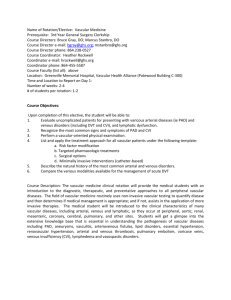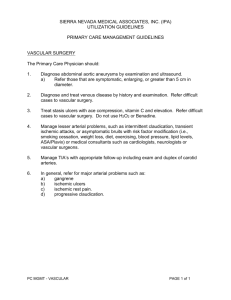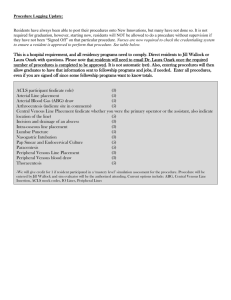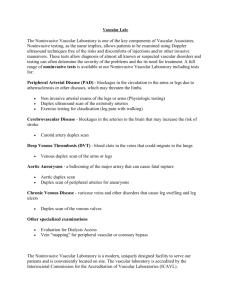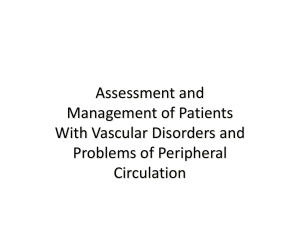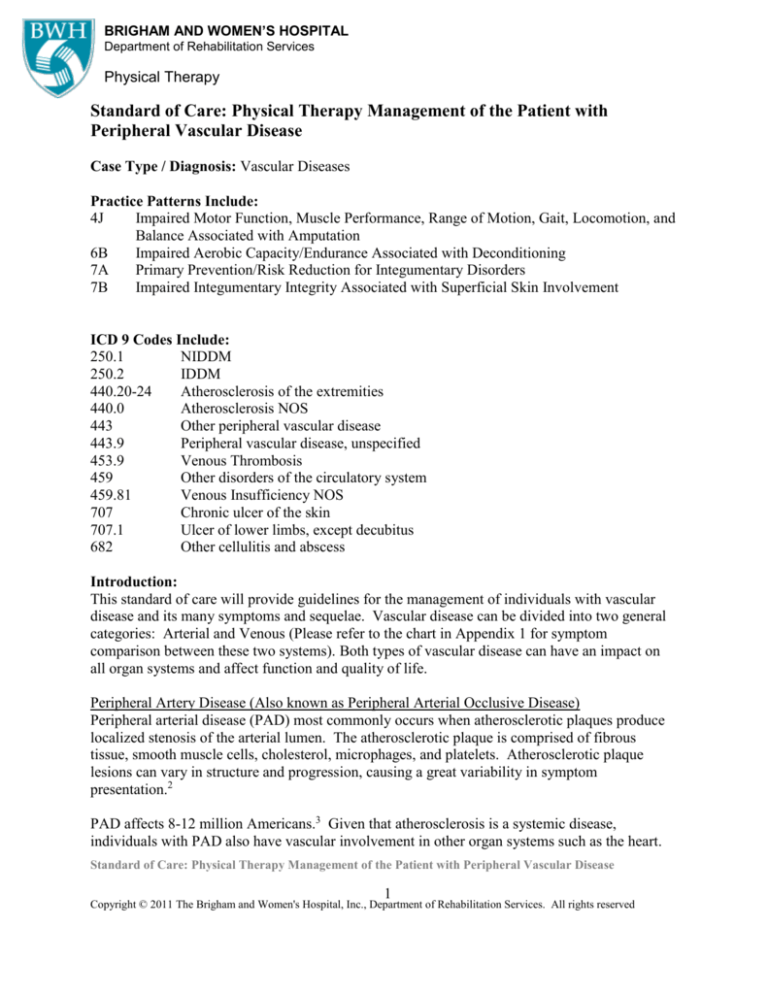
BRIGHAM AND WOMEN’S HOSPITAL
Department of Rehabilitation Services
Physical Therapy
Standard of Care: Physical Therapy Management of the Patient with
Peripheral Vascular Disease
Case Type / Diagnosis: Vascular Diseases
Practice Patterns Include:
4J
Impaired Motor Function, Muscle Performance, Range of Motion, Gait, Locomotion, and
Balance Associated with Amputation
6B
Impaired Aerobic Capacity/Endurance Associated with Deconditioning
7A
Primary Prevention/Risk Reduction for Integumentary Disorders
7B
Impaired Integumentary Integrity Associated with Superficial Skin Involvement
ICD 9 Codes Include:
250.1
NIDDM
250.2
IDDM
440.20-24
Atherosclerosis of the extremities
440.0
Atherosclerosis NOS
443
Other peripheral vascular disease
443.9
Peripheral vascular disease, unspecified
453.9
Venous Thrombosis
459
Other disorders of the circulatory system
459.81
Venous Insufficiency NOS
707
Chronic ulcer of the skin
707.1
Ulcer of lower limbs, except decubitus
682
Other cellulitis and abscess
Introduction:
This standard of care will provide guidelines for the management of individuals with vascular
disease and its many symptoms and sequelae. Vascular disease can be divided into two general
categories: Arterial and Venous (Please refer to the chart in Appendix 1 for symptom
comparison between these two systems). Both types of vascular disease can have an impact on
all organ systems and affect function and quality of life.
Peripheral Artery Disease (Also known as Peripheral Arterial Occlusive Disease)
Peripheral arterial disease (PAD) most commonly occurs when atherosclerotic plaques produce
localized stenosis of the arterial lumen. The atherosclerotic plaque is comprised of fibrous
tissue, smooth muscle cells, cholesterol, microphages, and platelets. Atherosclerotic plaque
lesions can vary in structure and progression, causing a great variability in symptom
presentation.2
PAD affects 8-12 million Americans.3 Given that atherosclerosis is a systemic disease,
individuals with PAD also have vascular involvement in other organ systems such as the heart.
Standard of Care: Physical Therapy Management of the Patient with Peripheral Vascular Disease
1
Copyright © 2011 The Brigham and Women's Hospital, Inc., Department of Rehabilitation Services. All rights reserved
e.g. coronary artery disease, and the brain, e.g. cerebrovascular disease. They are at high risk for
myocardial infarction and stroke. Predisposing risk factors for PAD include smoking, diabetes,
hypertension, hypercholesteremia and male gender. The most common symptom of
mild/moderate PAD is intermittent claudication, defined as “walking-induced pain, cramping,
aching, tiredness, heaviness in one or both legs (most often calves) that does not go away with
continued walking and is relieved with rest”.3 Individuals with PAD involving the calf or foot
and diabetes have the poorest medical outcomes and require more surgical intervention.2
Early detection of PAD is a crucial step in avoiding the need for surgical intervention. Early
PAD is often diagnosed using the ankle-brachial index (ABI). This is a non-invasive test that
compares the systolic blood pressure (SBP) at the ankle to the brachial SBP (ankle SBP/brachial
SBP = ABI). An ABI less than .96 is suggestive of PAD. Non-surgical management includes
exercise, medication, and changes in lifestyle to minimize risk factors.4, 5 Smoking cessation has
the most positive impact, stopping PAD progression and even improving circulation. Remaining
active is also important. Many studies show that regular exercise including active and resistive
range of motion exercises, and walking “results in a measurable improvement in walking
distance, quality of life, and community-based functional capacity.”6 15 One study has even
shown that a “supervised treadmill exercise also increased brachial arterial flow-mediated
dilation and improved quality of life”15 Exercise and ambulation may prevent or slow the
progression of PAD. Unfortunately individuals with PAD and resulting claudication often have
an insidious decrease in activity and walking in response to discomfort. They also may have the
incorrect belief that walking can cause them injury. This decrease in activity causes faster
progression of PAD.7 It is important to provide early education about how, in many cases,
ambulation and exercise can slow the progression of the disease. The goal of surgery is to regain
adequate blood flow thus relieving pain, improving function and quality of life and prolonging
patient survival.16 Unfortunately, most patients with lower limb ischemia have a heavy disease
burden related to their comorbidities. The 5-year survival rate is poor.16
Venous Disease
Venous insufficiency occurs when the venous system is unable to provide adequate antegrade
blood flow back toward the heart, i.e. venous return, and fails to prevent retrograde flow into the
extremities.
Venous disease can manifest in minor ways such as varicose veins which affect the superficial
veins or more advanced as in chronic venous stasis which affect the deeper veins. The changes
that are seen in deep vein disease are most commonly caused by deep vein thrombosis (DVT).
Reflux disease due to venous valvular incompetence accounts for 80% of chronic venous
insufficiency (CVI). The venous valve leaflets can become thickened, shortened or embedded in
scarred vein wall during the process of phlebetic inflammation. The vein becomes rigid and
thickened with fibrious material crossing the lumen.2
Venous disease can be congenital or of unknown etiology. Factors that increase the risk of
venous disease are pregnancy and hormone therapy. Physical symptoms of venous disease
include ankle edema, subcutaneous fibrosis, brownish skin discoloration, eczema, and dilation of
subcutaneous veins. Arterial pulses are usually present. Disease which occurs below the knee
appears more commonly in the more severe cases of venous insufficiency. Severe CVI often
includes the development of chronic, difficult to heal ulcers.
Standard of Care: Physical Therapy Management of the Patient with Peripheral Vascular Disease
2
Copyright © 2011 The Brigham and Women's Hospital, Inc., Department of Rehabilitation Services. All rights reserved
Typically the symptoms of CVI can be managed nonsurgically. Treatment focuses on leg
elevation and compression to decrease edema, the management of infected ulcers with local
wound care such as debridement using pulsatile lavage or topical enzymatics, and antibiotics.
The ultimate goals are to heal and/or prevent ulcers and preserve a functional lifestyle. The size
of the ulcer, length of time the ulcer has been present, and the amount of early healing that
occurs in the first three weeks, are important predictors of successful nonoperative therapy.10
Studies such as that done by Padberg and Johnston suggest that exercise that improves calf
muscle strength may improve the pump function of calf muscles, thus improving venous return.10
The average peak venous velocity increases at least 200% with active ankle dorsiflexion.8
Surgical intervention is mostly focused on management of venous stasis ulcers with
irrigation/debridement and skin grafting.
As mentioned previously, vascular disease is systemic and can affect any part of the body,
including the upper extremities. Individuals with renal disease requiring dialysis are at the
highest risk for upper extremity involvement as their dialysis access is most commonly located in
their arms. These grafts (most often a polytetrafluorethylene or PTFE graft) are at high risk for
clotting and infection, partly due to the synthetic material used and also because of the dialysis
patients’ comorbidities such as diabetes and cardiac disease. These thrombi often require
surgery (e.g., thrombectomy, dialysis access revision). Less frequently, upper extremities can
require the same interventions as lower extremities, such as bypass grafts or wound management.
DVT can also be a manifestation of venous disease. Two million Americans develop DVT each
year.8 DVT is the most common cause of secondary venous disease. Conversely venous stasis
can cause DVTs. Venous stasis “promotes thrombus formation by reducing clearance of
activated coagulation factors."9 Symptoms of DVTs can include skin that is warm to the touch,
blue/brown/red skin discoloration, dependent edema, and pain with palpation. There are several
types of DVT. Deep calf thrombi are generally small and asymptomatic but 30% can extend into
proximal veins within 1-2 weeks. 12 There is a low risk of pulmonary embolus (PE) and the best
treatment is early mobilization. Proximal DVT (popliteal or more proximal) tend to be more
symptomatic and have a 50% risk of PE. In cases of proximal DVT, there is a higher incidence
of PE with activity resumption within 48 hours so caution should be taken.12
The most common treatment of DVT is anticoagulant medication17 (e. g. Heparin, Lovenox,
Coumadin, Fragmin, Bivalirudin, Argatroban). The treatment most commonly used at Brigham
and Women’s Hospital is Heparin until partial prothrombin time is therapeutic, 60-80 seconds,
then transition to Coumadin with a goal INR of 2-3.18 Fragmin is an anticoagulant medication
that is used when a patient has an allergy to Heparin. There are no lab value parameters when
Fragmin is used because dosage is determined by weight. According to Dr. Samuel Z.
Goldhaber, Director of the BWH Anticoagulation Service, Fragmin reaches therapeutic levels in
“about an hour”. Another source indicates that it is safe to mobilize a patient 3-5 hours after the
first injection of Fragmin. 22 Use of anticoagulation medications is highly effective in preventing
DVT extension, embolization and recurrence.8 In cases where heparin is used there is a 5% risk
of major bleeding and a 1% risk of inducing thrombocytopenia.8 It is important to note that
anticoagulation does not eliminate an existing DVT. It can take the body months to absorb the
clot.
Standard of Care: Physical Therapy Management of the Patient with Peripheral Vascular Disease
3
Copyright © 2011 The Brigham and Women's Hospital, Inc., Department of Rehabilitation Services. All rights reserved
There are several factors that can reduce the risk of DVT. Activity, especially walking and
exercise, causes skeletal muscle pumping which decreases venous stasis. Effective hydration
and anticoagulation are also important. Compression that assists with venous return such as use
of graduated compression stockings or pneumatic compression devices can also be effective.8
Figure 1
Vascular anatomy of the lower extremities. From www.ohsu.edu
Common Surgical Procedures for the management of Peripheral Vascular Disease
1. Carotid Endarterectomy (CEA)
2. Abdominal Aortic Aneurysm Repair—open (AAA) or endovascular (EVAR)
3. Thoracic Aortic Aneurysm Repair, open (TAA) or endovascular (TEVAR)
4. Aorto-bifemoral bypass graft
5. Axillo-femoral bypass graft
6. Femoral-popliteal bypass graft [above knee (AK) or below knee (BK)]
7. Femoral-anterior tibial bypass graft
8. Popliteal-dorsalis pedis bypass graft
Standard of Care: Physical Therapy Management of the Patient with Peripheral Vascular Disease
4
Copyright © 2011 The Brigham and Women's Hospital, Inc., Department of Rehabilitation Services. All rights reserved
9. Tibial-dorsalis pedis bypass graft
10. Amputations [above knee (AKA), below knee (BKA), transmetatarsal (TMA), toe
amputations]. (See Amputation Standard of Care for additional information about the
management of patients following an amputation)
11. Debridement and skin grafting of decubitus ulcers due to PAD or venous
stasis/insufficiency (See Wound Care Standard of Care for additional information about
patients with integument issues)
Indications for Treatment: Some of the problems that patients with impaired peripheral
vascular systems present with are impaired skin integrity, pain, decreased endurance and
impaired mobility. Patients with impaired skin integrity can develop ulcers which often do not
heal on their own. Decreased activity and mobility as well as pain can result in weakness, joint
contractures, impaired aerobic capacity, and edema. The converse is also true, that is that
weakness, contractures and edema can cause decreased function and increased pain. All these
problems can lead to patients having difficulty performing activities of daily living (ADL) and
complying with medical interventions. Patients may also lack knowledge about weight-bearing
restrictions, wound healing and skin protection, safety awareness, and the importance of activity
progression. Physical therapy can be involved with addressing all these problems in a variety of
ways.
Contraindications / Precautions for Treatment:
Contraindications:
Orders for strict bedrest preclude Physical Therapy intervention. Reasons for bedrest
order include excessive bleeding, critical ischemia of an extremity, post-op day 1 of a
distal LE revascularization, post-op from a skin graft
Patients with femoral line intravenous access are put on bedrest at Brigham and Women’s
Hospital and repetitive hip range of motion is not done. The thought is that repetitive hip
ROM can introduce bacteria into the access site or increase the risk of arterial bleeding.
In an article by Perme C. Lettvin C. Throckmorton T. et. al., however, thirty patients with
femoral arterial catheters performed ambulation supervised by physical therapists without
any adverse affects.20
Patients with unstable heart rate, unstable blood pressure and fevers of more than 102
degrees are not appropriate for physical therapy
Precautions:
The following are commonly approved precautions for vascular surgery service, however
individual physician preference or individual cases may differ
Open great toe amputations: patients are heel weightbearing to minimize pressure on
amputation site that might slow healing
Closed great toe amputations: Patients are on bedrest for 24hrs postoperatively, then
are non-weightbearing to prevent increased pressure on incision that might cause
dehiscence
Peripheral artery revascularization: Patients are weightbearing as tolerated. In above
knee bypass procedures positioning the operative leg in hip/knee flexion more than 90
degrees for more than ½ hour should be avoided to prevent tension on the vein graft.
For bypasses of the distal vasculature (involving the dorsalis pedis artery), patients
Standard of Care: Physical Therapy Management of the Patient with Peripheral Vascular Disease
5
Copyright © 2011 The Brigham and Women's Hospital, Inc., Department of Rehabilitation Services. All rights reserved
are on 24 hours of bedrest post-operatively as the vasculature is smaller and more
fragile.
Aortic Aneurysm repairs: Patients should avoid lifting/pulling/pushing more than
10lbs, avoid sit-ups and excessive twisting of trunk all of which can increase intraabdominal pressure and put tension on the repair. Patients should also use logroll bed
mobility to minimize tension on the repair.
Skin breakdown, chronic ulcers: Activity precautions vary depending on location and
treatment. There may be weightbearing restrictions if the area of breakdown is on the
plantar surface of the foot. Confer with physician, physician’s assistant (PA) or nurse
practitioner (NP) for specifics on individual patients
Venous Stasis: Patents should keep their legs should be elevated above the level of
the heart in bed and chair to facilitate venous return and edema control. Ambulation
should be encouraged as the pumping action of the muscles can assist the with venous
return
Patients on dialysis may experience significant fatigue and hypotension after dialysis
which decreases their tolerance for Physical Therapy intervention. Attempts to schedule
treatments before dialysis or on non-dialysis days should be made
Evaluation:
Medical History: Pertinent past and ongoing medical issues that may impact response to
treatment include, but are not restricted to, diabetes and its sequelae such as neuropathy,
nephropathy, retinopathy, prior vascular surgeries, and use of tobacco or ETOH
History of Present Illness:
Surgical procedures and other interventions such as stenting
Relevant medications (pain control, anticoagulants, thrombolytics)
Medical complications
Mental status changes
Hospital Course:
Pertinent lab values [international normalized ratio (INR), prothrombin time (PT), partial
thromboplastin time (PTT), Hematocrit, Platelets, White Blood Cells]
Lab values related to comorbidities (Creatinine, Blood Urea Nitrogen, blood glucose
levels)
ABI value in those with PAD
Ultrasounds (upper extremity or lower extremity non-invasives) to rule out DVTs
Angiogram results
Social History:
Specifics about home environment, architectural barriers
Family support, normal role in family
Baseline level of function
Ability of patient to comply with precautions in the past
Adaptive equipment used and tried currently and in the past
Psychosocial issues, substance abuse issues
Standard of Care: Physical Therapy Management of the Patient with Peripheral Vascular Disease
6
Copyright © 2011 The Brigham and Women's Hospital, Inc., Department of Rehabilitation Services. All rights reserved
Examination
Cardiopulmonary
Assess patient’s cardio-pulmonary status during activity by monitoring vital signs;
auscultating lungs for present of rales, rhonchii, wheezes; and observing patient for signs of
dyspnea. Doing this is especially important in patients with significant cardiac or pulmonary
comorbidities, which are common in patients with vascular disease. Surgery can exacerbate
existing cardiac and pulmonary problems. It can also cause acute decrease in
cardiopulmonary status due to depressed respiration rate during surgery and fluid overload
from IV administration. In addition to objective values, a patients response to activity should
be measured using the Borg Scale; this indicates how hard a patient feels they are working
during activity.
Integument
Observe surgical incisions for presence of drains, integrity of sutures/staples, amount and
quality of drainage, type of dressing being used. Note presence of open areas (e.g. open
toe amputations or incisions that have been left open due to edema)
Check skin integrity, including color, trophic changes (thickness, hairlessness, flaking).
Note presence of open wounds. Note size (length, width, and depth), type of tissue
present and amount of each. Refer to Wound Care Standard of Care which includes a
detailed wound assessment screening chart
Examine extremities for edema. Edema after surgery can be acute or chronic.
Circumferential measurements can be used to monitor changes in edema
Musculoskeletal
Range of motion is measured using goniometric measurements. Incisions that cross the
joint line increase risk of contracture due to pain and edema that make patients hesitated
to move the operative area
Strength is measured using manual muscle test (MMT) if patient is able to participate. If
not, functional and spontaneous active motion can be observed and documented. In many
cases a patient will not tolerate resistance to a newly operative limb, so measurement may
restricted to a MMT of 3/5 or less
Neuromuscular
Pain is measured using Visual Analog Scale (VAS) (0-10). Consider pre-medication for
pain. Communicate to nursing regarding pain during activity, need for additional pain
medication. Instruct patient in deep breathing and relaxation techniques for pain control
Always assess patient’s ability to perceive light touch. If it is impaired, assess ability to
perceive sharp-dull and deep pressure sensations as sensation impairments can impact
skin integrity and balance. Also assess patient’s proprioception which is also commonly
impaired in patients with PAD. These patients often have peripheral neuropathy which
can cause the sensation impairments
Balance can be impaired in patients with vascular insufficiency. Balance can be affected
by sensation deficits. More details can be found in the Balance Standard of Care.
Standard of Care: Physical Therapy Management of the Patient with Peripheral Vascular Disease
7
Copyright © 2011 The Brigham and Women's Hospital, Inc., Department of Rehabilitation Services. All rights reserved
Balance can be assessed by a variety of balance test such as the Berg Balance
Assessment, Dynamic Gait Index, Function in Sitting
Functional Capacity
Functional mobility including use of ambulatory devices, lifts
Mental Status and Cognition
Level of consciousness
Orientation
Safety judgment
Ability to follow direction and comply with restrictions (especially regarding level of
activity and weightbearing status)
Psychological Considerations
Learning style
Patient's goals for recovery
Impact of psychiatric disorders on participation and recovery
Assessment:
Problem List (This is not an exhaustive list and problems can vary among individual
patients)
Impaired range of motion of involved extremities
Edema
Presence of/risk for skin breakdown
Impaired mobility
Impaired endurance
Impaired respiratory status
Impaired balance
Impaired strength
Knowledge deficit regarding precautions, activity progression, healing process
Pain
Sensation deficits
Prognosis:
Symptomatic vascular disease can impact an individual’s functional level in a variety of ways.
Claudication pain, skin breakdown and weightbearing restrictions can all limit activity and affect
quality of life.19 Many studies have detailed the benefits of various types of exercise.
McDermott et. al. showed that group participation in a supervised treadmill program and lower
extremity resistance training improved 6 minute walk performance, brachial artery flowmediated dilation, stair climbing ability and quality of life.14 Other studies document that
exercise increases quality of life and activity level even without improvement in brachial artery
flow.6 19 These findings show that a progressive walking program and exercises can be beneficial
in any person with vascular disease admitted to the hospital and improve their functional and
vascular prognosis.
Standard of Care: Physical Therapy Management of the Patient with Peripheral Vascular Disease
8
Copyright © 2011 The Brigham and Women's Hospital, Inc., Department of Rehabilitation Services. All rights reserved
Early activity and an active lifestyle can also benefit those people who do require surgical
intervention. Flu HC et. al. found that pre-operative functional level can be predictive of
recovery from revascularization surgery. Individuals who were more active and functional did
better than more impaired or sedentary patients. They note that non-ambulatory patients
“infrequently experience improvement in functional status after LEAR (lower extremity arterial
revascularization), they frequently experience AEs (adverse effects) and reinterventions and have
especially poor long-term survival rates”.16 Given that some studies, such as McDermott et. al.
show that activity can improve arterial flow, it is reasonable to extrapolate that, even during a
hospitalization following vascular surgery, working to optimize a patient’s mobility and activity
is beneficial. Although functional level varies widely among patients at time of discharge,
physical therapists help by progressing mobility, making recommendations about equipment and
discharge destination. The earlier a patient starts moving and mobilizing, the better the
functional outcome.
Suggested Goals
ROM: ankle dorsiflexion to at least neutral and knee flexion at least 90 degrees to allow
heel-toe gait pattern
Prevent or minimize skin breakdown
Strength at least 3/5
Independent mobility with appropriate assistive devices, specialized footwear as needed
Tolerates physical therapy intervention with appropriate hemodynamic response to
activity
Demonstrates knowledge of healing process, activity progression, precautions,
independent exercise program
Treatment Planning / Interventions
Established Pathway
___ Yes, see attached.
_X_ No
Established Protocol
___ Yes, see attached.
_X_ No
Interventions most commonly used for this case type/diagnosis:
Mobility Progression
Functional Activities such as bed mobility, transfers, gait on level and unlevel
surfaces with an appropriate assistive device, stairs
Positioning
Appropriate splints to protect, immobilize, relieve pressure and elevate extremities
should be provided. At BWH prevalon boots are commonly used for pressure relief of
the heels. Rolyan resting foot splints are used for pressure relief, immobilization and
ankle/foot positioning
Edema management
Especially for individuals with venous disease, it is important to minimize edema.
Management can include compression using ace wraps, coban or elastic stockinette.
Use of these materials should be discussed with the vascular surgery team. Skin
integrity should also be assessed to ensure that it will tolerate the pressure of the
Standard of Care: Physical Therapy Management of the Patient with Peripheral Vascular Disease
9
Copyright © 2011 The Brigham and Women's Hospital, Inc., Department of Rehabilitation Services. All rights reserved
compressive items. Active exercise and elevation are also components of edema
control
Integument
Specialized footwear prescription to off-load portions of the foot depending on
the surgical site. Particular physician preference also needs to be considered. At
BWH flat soled post-op shoes, heel weightbearing shoes and forefoot
weightbearing shoes are available. Custom-made footwear may be needed in
isolated cases. “Offloading is important for reducing foot pressure points and for
prevention, as well as for healing”.21
Wound care such as pulsatile lavage can be initiated for open wounds that have
been slow to heal and contain necrotic tissue(refer to Wound care SOC)
Range of Motion, Stretching and Strengthening
Active, active assisted, passive ROM and stretching as tolerated can be performed to
preserve and increase flexibility and strength. Ideally the incision site should be
visible during stretching so as not to overly stress the incision. Resistive exercises as
tolerated can increase strength but also improve circulation and decrease
claudication 6 15
Endurance
A progressive activity program that includes progressive ambulation, exercises
performed in increasing repetition and frequency can increased a patient’s activity
tolerance. A stationary bike, treadmill, elliptical can also be used.
Pulmonary Conditioning
Pulmonary status, similar to endurance, can be addressed by instruction of a
progressive activity and exercise program for home use. Individuals can walk, use a
treadmill, stationary bicycle or other type of aerobic equipment and start at a low
duration. They can then increase the amount of time they exercise, with a goal of
RPE of “moderate” or rating of 3-5/10 on the Modified Borg Scale. These
conditioning activities have added benefits of increasing muscle strength and blood
flow. Exercises can be done that focus on strengthening respiratory muscles such as
the diaphragm and trunk musculature. For people with a lower activity tolerance as
well as all patients, education about pacing, modification of activities, energy
conservation, and effective deep breathing can be useful in improving quality of life
and level activity
Frequency & Duration
The intensity of physical therapy intervention in the acute care setting depends on several
things. Although treatment frequency varies, patients are typically seen 3-5 times weekly.
Patients with less complicated surgeries such as an endovascular AAA repair often
require only a few treatments, while a patient with a complex revascularization or chronic
skin breakdown requires more frequent, ongoing physical therapy.
Medical issues that arise can impact length of stay and the patient’s ability to progress
toward goals. Length of stay can vary widely in this group of individuals depending on
complexity of the surgery or the severity of the disease. Patients can be at BWH from
several days for a patient with an uncomplicated revascularization procedure to several
weeks or longer for a patient with more complex vascular medicine issues. A patient’s
Standard of Care: Physical Therapy Management of the Patient with Peripheral Vascular Disease
10
Copyright © 2011 The Brigham and Women's Hospital, Inc., Department of Rehabilitation Services. All rights reserved
level of impairment will dictate what goals need to be addressed and what the best
discharge destination should be.
Patient / family / caregiver education
Discussion with patient and family/caregivers regarding physical therapy involvement
with patient and expected progression should include:
Detailed explanation of weightbearing restrictions and discussion of importance
of compliance for optimal healing
Discussion of importance of moving affected extremity (within precaution
parameters) to prevent joint contractures, particularly at the ankle and knee
Instruction of patient and family/caregivers in appropriate exercises and activities
Patients and family should be instructed in a skincare regimen including daily check
of problem areas to ensure no new skin breakdown. This is especially important in
individuals with impaired sensation. Shoes should also be checked for proper fit and
modified by an orthotist or podiatrist. Patients should be encouraged to contact their
physicians quickly if any skin or wound changes occur
Recommendations and referrals to other providers
Social Work/Care Coordination
Occupational Therapy
Psychiatry
Orthopedic Technician
Prosthetist/Orthotist
Re-evaluation
Standard Time Frame: 10 days or sooner as appropriate
Other Possible Triggers: A significant change in signs and symptoms, new surgical
procedure, significant progress with PT intervention requiring re-assessment of needs
Discharge Planning
Commonly expected outcomes at discharge:
Return to at least baseline function
Maximal range of motion
Patient is independent with exercise program and walking program
Patient is independent with skin inspection
Transfer of Care
Home with services if the patient has good support system and safe living situation
but continues to have impairments and functional limitations that could be improved
with further physical therapy intervention. Intervention at home can also work to
educate family on how to optimally care for and/or assist the patient
Home with family assistance if the patient is able to mobilize and function safely
without assistance or family is proficient in caring for and assisting the patient
Standard of Care: Physical Therapy Management of the Patient with Peripheral Vascular Disease
11
Copyright © 2011 The Brigham and Women's Hospital, Inc., Department of Rehabilitation Services. All rights reserved
Extended care facility patient requires extensive skilled medical care for safety and
requires ongoing physical therapy to make functional progress
Patient’s discharge instructions
Progressive activity program including use of activity log
Weightbearing restrictions
Management of assistive devices and other equipment such as or intravenous pump
poles
ROM and strengthening exercise program
Proper management of positioning devices and splints including wearing schedule,
don/doff procedure
Author:
Alisa G. Finkel,PT
12/2011
Reviewed by:
Barbara Odaka, PT
Robert Camarda, PT
Merideth Donlan, PT
Kristen Maurer, PA Vascular Surgery
Standard of Care: Physical Therapy Management of the Patient with Peripheral Vascular Disease
12
Copyright © 2011 The Brigham and Women's Hospital, Inc., Department of Rehabilitation Services. All rights reserved
REFERENCES
1. Guide to Physical Therapist Practice, Second Edition, APTA, January, 2001.
2. Loscalzo J, Creager MA, Dzau VJ. Vascular Medicine: A Textbook of Vascular Biology
and Diseases, Second Edition. Boston, MA: Little, Brown and Company; 1996.
3. Milani RV, Lavie CJ. The Role of Exercise Training in Peripheral Arterial Disease.
Vascular Medicine. 2007:12:351.
4. Moore WS. Vascular and Endovascular Surgery: A Comprehensive Review Seventh
Edition. Philadelphia, PA: Saunders Elsevier; 2006.
5. Wang E.Hoff J.Loe H, Kaehler N. Helgerud J. Plantar Flexion: An Effective Training
for Peripheral Arterial Disease. European Journal of Applied Physiology. 104:749-755.
2008.
6. Moore WS. Vascular and Endovascular Surgery: A Comprehensive Review Seventh
Edition. Philadelphia, PA: Saunders Elsevier; 2006: 272.
7. Treesak M. Kasemsup V. Treat-Jacobson D. et. al Cost-effectiveness of Exercise
Training to Improve Claudication Symptoms in Patients with Peripheral Arterial Disease.
Vascular Medicine. Volume 9. 2004. Pages 279-285.
8. Tepper, Steve PhD, PT. Course: Deep Vein Thrombosis (DVT) and Peripheral Arterial
Occlusive Disease (PAOD): Management of Patients with Lower Extremity Vessel
Disorders. 9/27/09, Somerville, NJ.
9. Rutherford RB. Vascular Surgery Sixth Edition. Philadelphia, PA: Saunders Elsevier;
2005.
10. Padberg FT. Johnston MV. Sisto SA. Structured Exercise Improves Calf Muscle Pump
Function in Chronic Venous Insufficiency: A Randomized Trial. Journal of Vascular
Surgery. Volume 39, Issue 1:79-87.
11. Ciccone CD. Clinical Question: Does Ambulation Immediately Following An Episode of
Deep Vein Thrombosis Increase the Risk of Pulmonary Embolism? Physical Therapy.
Vol 82, Number 1:84-88. 2002.
12. Goodman C. Boissonnault. Pathology: Implications for the Physical Therapist. WB
Saunders Company, 1998, Chapter 10, page 317.
13. Sussman C. Bates-Jensen B. Wound Care; A Collaborative Practice Manual for Physical
Therapists and Nurses. Gaithersburg, MD: Aspen Publishers, Inc; 2001, page 179.
Standard of Care: Physical Therapy Management of the Patient with Peripheral Vascular Disease
13
Copyright © 2011 The Brigham and Women's Hospital, Inc., Department of Rehabilitation Services. All rights reserved
14. Collins TC. Beyth RJ. Process of Care and Outcomes in Peripheral Arterial Disease.
American Journal of the Medical Sciences. Volume 325, Number 3, March 2003.
15. McDermott M. Ades A. Guralnik J. et. al. Treadmill Exercise and Resistance Training in
Patients with Peripheral Arterial Disease with and without Intermittent Claudication.
Journal of the American Medical Association. Volume 301, No. 2, 2009, pages 165-174.
16. Flu H. Lardenoye J. Veen E. et. al. Functional Status as a Prognostic Factor for Primary
Revascularization for Critical Limb Ischemia. Journal of Vascular Surgery. Volume 51,
Number 2. 2008. pages 360-371.
17. Aldrich D. Hunt DP. What Can the Patient With Deep Vein Thrombosis Begin to
Ambulate? Physical Therapy. Volume 84, Number 3, March 2004
18. Partners Handbook. Venous Thromboembolism Guidebook, 5th Edition
19. Crowther RG. Spinks WL. Leicht AS. et. al. Effects of a Long-term Exercise Program on
Lower Limb Mobility, Physiological Responses, Walking Performance, and Physical
Activity Levels in Patients with Peripheral Artery Disease. Journal of Vascular Surgery.
Volume 47, Number 2. February 2008.Pages 303-309.
20. Perme C. Lettvin C. Throckmorton TA. Mitchell K. Masud F. Early Mobility and
Walking for Patients with Femoral Arterial Catheters in Intensive Care Unit: A Case
Series. Journal of Acute Care Physical Therapy. Volume 2, Number 1, Spring 2011.
21. Snyder RJ.Lanier KK. Offloading Difficult wounds and Conditions in the Diabetic
Patient. Ostomy Wound Management. Volume 48, Number 1, 2002. page 22
22. Costello E, Elrod C, Tepper S. Clinical Decision Making in the Acute Care Environment:
A Survey of Practicing Clinicians. JACPT. 2011; 2: 46-54.
Standard of Care: Physical Therapy Management of the Patient with Peripheral Vascular Disease
14
Copyright © 2011 The Brigham and Women's Hospital, Inc., Department of Rehabilitation Services. All rights reserved
APPENDIX 1
Comparison of Arterial and Venous Disease Symptoms13
Arterial
Venous
Pain
Intermittent claudication, may Chronic, dull aching pain
progress to pain at rest
which progresses throughout
the day
Color
Pale to dependent rubor, dull
Normal to cyanotic
to bright reddish color
Skin temperature
Takes on environmental
Normal
temperature, cool
Pulses
Diminished to absent
Normal but difficult to palpate
due to edema
Edema
Not present with isolated PAD Present, can be pitting. Can
have weeping of serous fluid
Tissue changes
Skin is shiny with hair loss.
Stasis dermatitis with flaky
Trophic changes in nails,
dry and scaly skin. Can have
muscle wasting
brownish discoloration.
Fibrosis with narrowing of the
lower legs (“bottle legs”)
Wounds
Occur distally especially at
Shallow ulcers on the foot and
toes and web spaces. May
ankle, usually medially
develop gangrene and tissue
loss
From Sussman C.Bates-Jensen B. Wound Care; A Collaborative Practice Manual for Physical Therapists and Nurses. Aspen Publishers,
Inc.2001, page 179.
Standard of Care: Physical Therapy Management of the Patient with Peripheral Vascular Disease
15
Copyright © 2011 The Brigham and Women's Hospital, Inc., Department of Rehabilitation Services. All rights reserved

